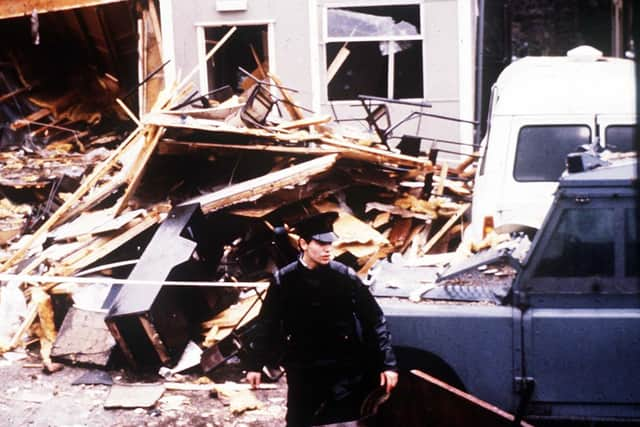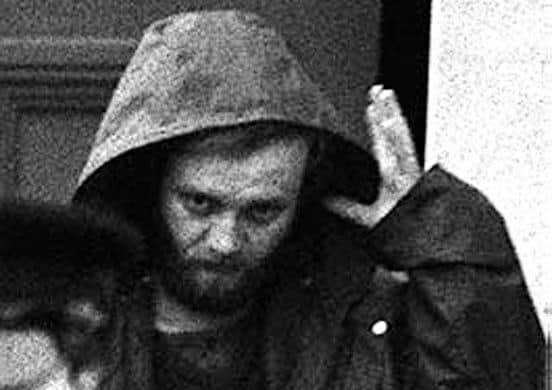Newry RUC station attack anniversary: Ex-officer says ‘pure carnage’ wreaked by IRA never leaves him
and live on Freeview channel 276
He also warned that at present it appears as if people are more willing to pillory the RUC than the paramilitaries who committed the vast bulk of the bloodshed, and that the current legal cases all seem to be “one way”.
The News Letter knows the identity of the man, a 63-year-old living outside Belfast, but due to security concerns have agreed to withhold his name.
Advertisement
Hide AdAdvertisement
Hide AdIn all, nine officers died when the IRA launched a series of mortar bombs at Newry police station on February 28, 1985 – the highest death toll of any attack on police.


The retired officer, who has never spoken to the press before, told the News Letter “the camaraderie was second to none” at the station, adding: “It was a very active place for terrorism – it was a hub for the whole of south Armagh. The fact you were literally under pressure all the time, I think that drew people much closer together.”
“I started work that morning at 8am, working to 11pm that night,” he said.
“That was the intention. It was quite common at the time to work long shifts.
Advertisement
Hide AdAdvertisement
Hide Ad“Myself and two other guys were sitting in an office and we were having our dinner. And at 6.35pm that evening, which was a Thursday evening, Crossroads had just started on the television.


Then there were a series of bangs and the windows came in.
“I made my way out into the main corridor in the station, and was confronted by a uniformed police officer,” he said.
“He asked what was happening, and my words to him were: ‘I think we’re all about to die’.
“The next recollection is an officer, a more senior officers, coming in through the back door from the yard where the canteen was.
Advertisement
Hide AdAdvertisement
Hide Ad“And if you looked at him he looked like a typical cartoon character who has just been in an explosion.
“His shirt was in tatters and he said something to the effect: It’s gone.
“There were no more explosions, and myself and others ran out the back to where the canteen was. And it wasn’t there any more. It was just wreckage.
“And I remember there was a person sitting up in the middle of the wreckage, and it was a person I knew fairly well but I didn’t instantly recognise because of the state they were in. That was actually Rosemary McGookin. She was later pronounced dead on the way to hospital, I believe.
“It was just pure carnage.”
Advertisement
Hide AdAdvertisement
Hide AdThe canteen had been like a pre-fab mobile, which offered no protection from such an attack.
It was dark at the time, but there were security lights.
He was later sent home, and tried to give a comrade a lift in his car – but all that was left of it was a bit of red wreckage.
Speaking of the dead, the ex-officer said: “Some of them I knew better than others. But they were all just police officers doing their job. That’s all they were doing.
“They were having their dinner. They weren’t doing anything outstanding. They were normal people just doing their job.”
Advertisement
Hide AdAdvertisement
Hide AdThe funerals followed, and the investigation into the murders.
He was not in work for a few months after the attack.
The retired officer believes “there is no doubt” that top IRA intelligence man Eamon Collins was behind it - something Collins himself denied in his book Killing Rage (although he admitted to a string of other murders).
Ultimately his old IRA comrades in turn murdered Collins in Newry in 1999.
However, the retired officer wondered if the people who sanctioned the attack will “ever be brought to justice”.
Advertisement
Hide AdAdvertisement
Hide AdHe added: “The bottom line is I think an awful lot of people forget about this – the fact that we’re quite happy to pillory the RUC for doing their job but we’re not happy to pillory the terrorists for what they did.
“In my opinion as a police officer not once did I ever consider going out to do any body any harm.
“Every year, throughout the year, it’s something that never leaves you.
“And you think of those people who were just doing their job, having their dinner. Not just them - all the others that went before and came afterwards.
Advertisement
Hide AdAdvertisement
Hide Ad“It’s not something that goes away, and it’s not something I care to remember. At this time of the year it just becomes very prevalent.”
Referring to prosecutions of state forces and inquiries into state wrongdoing, he added that “you hear about all these public enquiries... and, I’m sorry, but it all seems to come one-way at the minute”.
The CAIN Troubles archive says that between 1969 and 2001 there were 301 NI police killed (as well as 18 ex-police).
Added to that are six British police, and nine Garda Siochana.
Advertisement
Hide AdAdvertisement
Hide AdThe RUC by contrast killed 55 (with Gardai killing four, and British police killing one).
The book Lost Lives lists these details for the dead:
• Alexander Donaldson (41, married with three children);
• Geoffrey Campbell (24, married);
• John Thomas Dowd, (31, married);
• Denis Anthony Price (22, single);
• Rosemary Elizabeth McGookin (27, married);
• Sean Brian McHenry (19, single);
• David Peter Topping (22, single);
• Paul Hillary McFerran (33, single);
• Ivy Winifred Kelly (29, married).